Public History: Integrating Digital Artifacts with Community Engaged Learning
Presented by eXp

Eastern Washington University houses many programs that apply learning beyond the traditional classroom experience. This includes finding meaningful ways to engage student learning with the needs of real-world public projects. Larry Cebula, professor in Eastern’s History Department, teaches public history, which focuses on all the ways historians interact with the public outside of the classroom. Students in his courses do work in museums, historic sites, in archives, and online. This includes a couple of different websites which Dr. Cebula created and edits, including spokanehistorical.org and IslandHistories.com. His courses always have a real-world class project, something public facing, that generally work with a community partner to help achieve its goals.
spokanehistorical.org is both a website and smartphone app with almost 700 digital historical exhibits, created by EWU students, including around 600 stories of local history. Often students will research a related set of stories for their work with a community partner, and the stories will become a tour. An example on the website is the tour “Spokane in World War Two” (seen below).
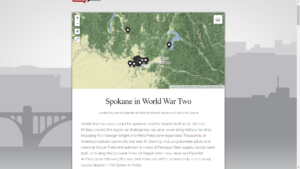
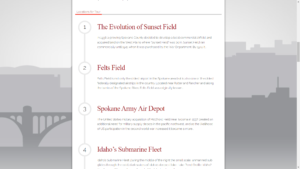
Sponsored by the Northwest Museum of Arts and Culture, the tour is an extension of the MAC’s “American Inheritance: Unpacking World War II” exhibit. The exhibit had many of its artifacts selected by students as part of Dr. Cebula’s 2020 Nearby History Course, which was co-taught with Freya Liggett, the History Curator at the museum. The tour took existing Spokane Historical stories and incorporated them with new stories from students of Dr. Cebula’s course. Several of the stories are directly related to the artifacts the students researched and expand upon those themes, others are additional stories not touched upon within the physical exhibit. The website’s tours work in unison with the courses, extending research done for community partners and archiving it on a public platform.
Here’s an example of one of the tour locations for “Baxter Hospital”. The site has a story for the location along with historical images and its location on the map.

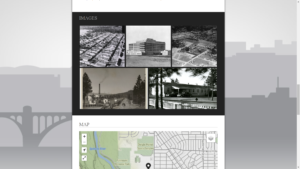

Nearly all of the tours are the byproduct of community engagement with a partner, from the MAC (4 exhibits/tours) the Spokane Valley Museum, the North Idaho Mining Museum, and the National Park Service, among others. Dr. Cebula’s 2020 course was especially interesting because of how the class had to adapt to COVID. He initially approached Freya in 2019 about possible projects for his 2020 Nearby History course, but the class began around the same time WA state employees were being asked to work from home.
The museum had already identified relevant batches of documents and objects that could help tell the local WWII story, so this forced the staff to figure out how to share archival and collection objects with the students virtually. They did this by digitizing hundreds of documents, taking new object photographs, and updating their collection records so everything would be accessible online. Dr. Cebula then added links to these in his course modules. “Ironically,” says Freya, “even though the whole process was almost entirely contact-free I think it was some of the best collaborative work our staff has done since I joined the museum in 2019!”
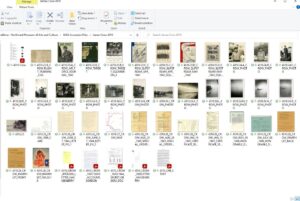

The students, however, did miss out on getting real hands-on experience in the archives, and meeting staff and subject specialists whose advice helped frame the exhibit focus. The trade-off was greater freedom to explore topics since most of the work was reaction based and self-directed. Student Harley Belisle’s project, for instance, explored the letters of Allan Powell, who died in the war and was the grandson of the Campbell family, who the land under the 1960 and 2001 buildings on the museum campus was gifted in memory to. It was the first time anyone had ever read the entire contents from front to back and became featured as a tour location on the spokanehistorical.org website and was one of the four stories featured in comic-book style panels by Cashmere WA artist Dan McConnell (pictures below).

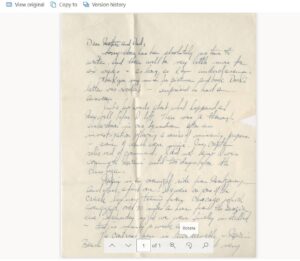
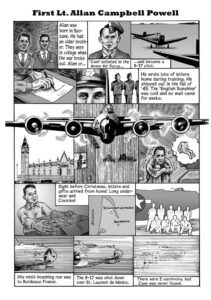
Freya says the in-class discussions and individual contributions played a “significant role in the content featured in the exhibit.” Rather than “being a guest a few times as originally planned, we learned about the war together.” The label text for many of the featured objects directly followed student’s papers, such as Dylan Steele’s object interpretation on “war trophies.” His interpretive outline not only guided the layout of his chosen object, a Japanese Bolt Action Rifle, but it’s relation to the other objects it was eventually displayed next to (like a Nazi Dress Dagger). The freedom the students had to choose their objects and topics contributed to the museum’s ability to tell a broad range of WWII stories that are still relevant in the present-day. Throughout the course, the students reached into their own experiences to share the ways the war influenced their families or their personal interests in history. Dylan wrote about his unresolved feelings about his own grandfather’s role fighting the war, for example. Did he take war trophies? Without a good family history, the personal details have been lost, “so how I remember the war is of importance to me.”
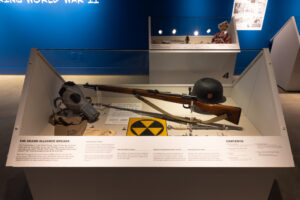
Freya says, “This project was a good example of how the internet has opened up doing hands-on history to a wider range of practitioners.” Student Tyson Eckert lauded technological access in one of his reaction papers writing, “I would say it is a good thing. It gives almost anyone who has even the slightest interest in learning their communities history the opportunity to do so.” The retired teacher who proofread the script and worked as a gallery docent described the exhibit as a “symphony” of experiences, a compliment Freya feels “best describes the influence of Larry’s EWU class, a recent Gonzaga graduate, and the humanities specialists that contributed to it.”

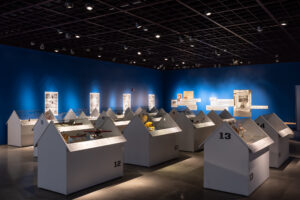

Dr. Cebula’s classes have also been working with the National Park Service and local museums in the San Juan Islands in recent years. They have a website, IslandHistories.com, and have twice taken students there to work with the National Park Service and twice scheduled a summer public history field school on the islands (and twice seen it cancelled due to COVID). This quarter, Dr. Cebula is working with the MAC to turn Jess Walter’s historical novel, The Cold Millions, into a museum exhibit at the MAC. The novel is set in the 1909 Free Speech Fight in Spokane. In the Fall, his Digital Humanities course will be working with Manhattan Project National Historical Park in Hanford to create stories to populate their new smartphone app. The stories will draw on the oral histories of radiation survivors at Hanford, known as the “Downwinders.”
Categories
Experts Directory
Find EWU faculty and staff who are experts in diverse subjects.
